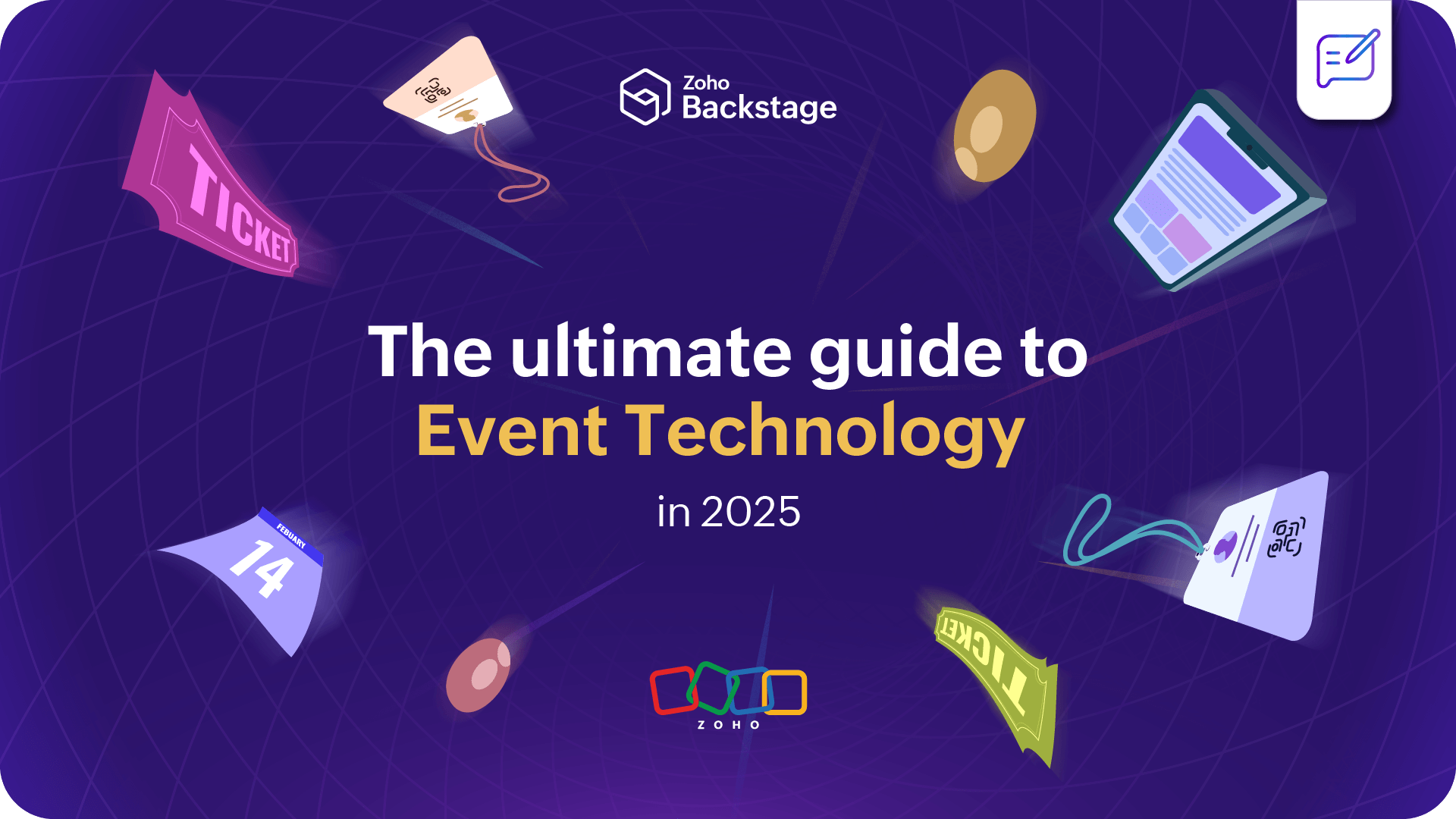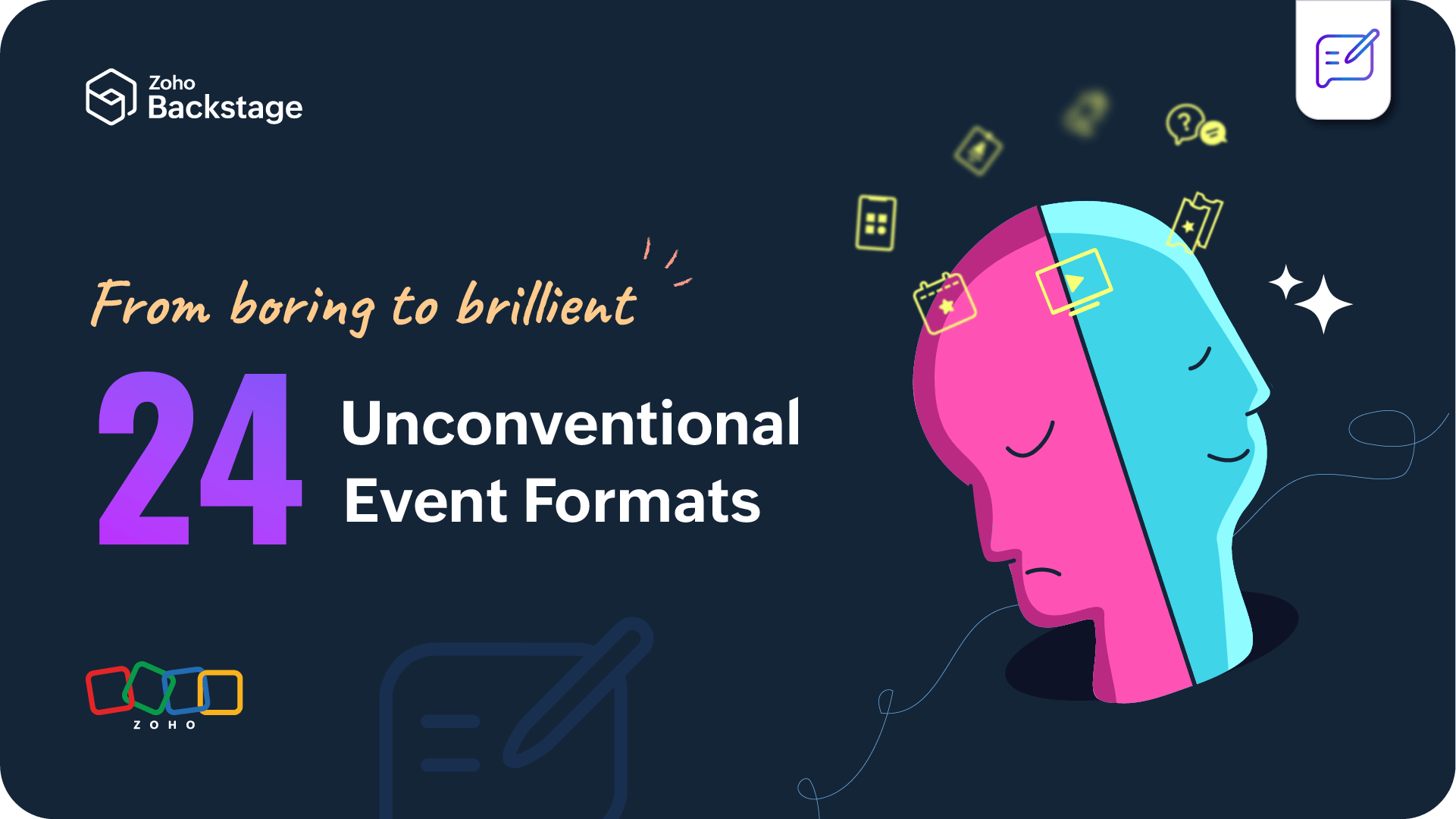- HOME
- Technology
- 2021 Events Industry Report
2021 Events Industry Report
- Last Updated : August 18, 2023
- 1.3K Views
- 8 Min Read
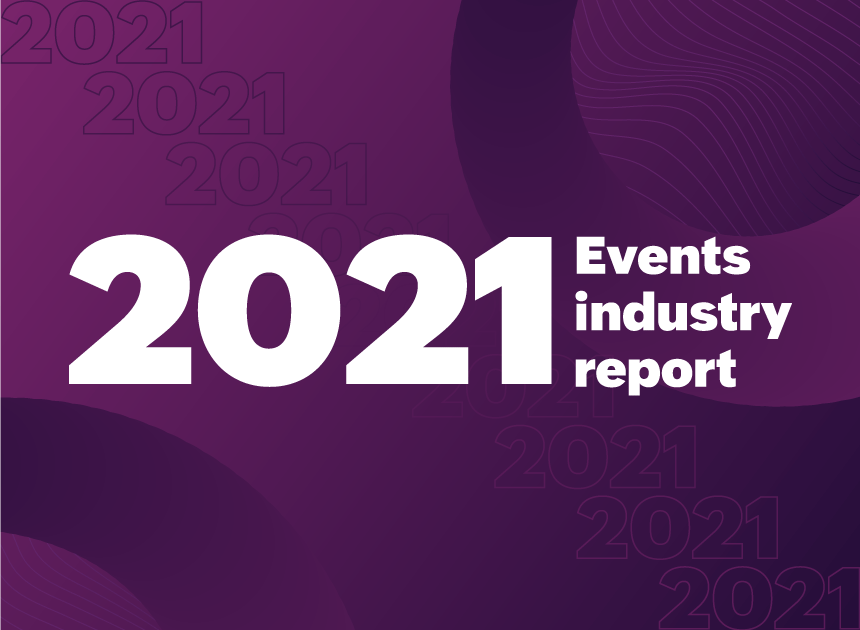
Towards the end of 2021, many publications worldwide asked people how they’d define the year’s theme. The answers varied from negative terms like redundant, restrictive, and exhausting to more positive terms like growth, empathy, and enlightenment. If we were to pick a word—for both the events industry and Zoho Backstage—it probably wouldn't be negative or positive. Instead, it’d fall somewhere in the middle. Something like progress or, more specifically, a work in progress.
For the most part, 2021 was a blurred extension of 2020. We either asked more questions or wrote (and rewrote) our answers to the questions that were raised in 2020. Most of the trends we saw in 2021 were also carried over from the previous year. Another trend that stayed all year long was people switching between event formats: virtual to hybrid to in-person to hybrid to virtual to...
Here’s a tweet that sums up the event industry’s back-and-forthing over the last few years:
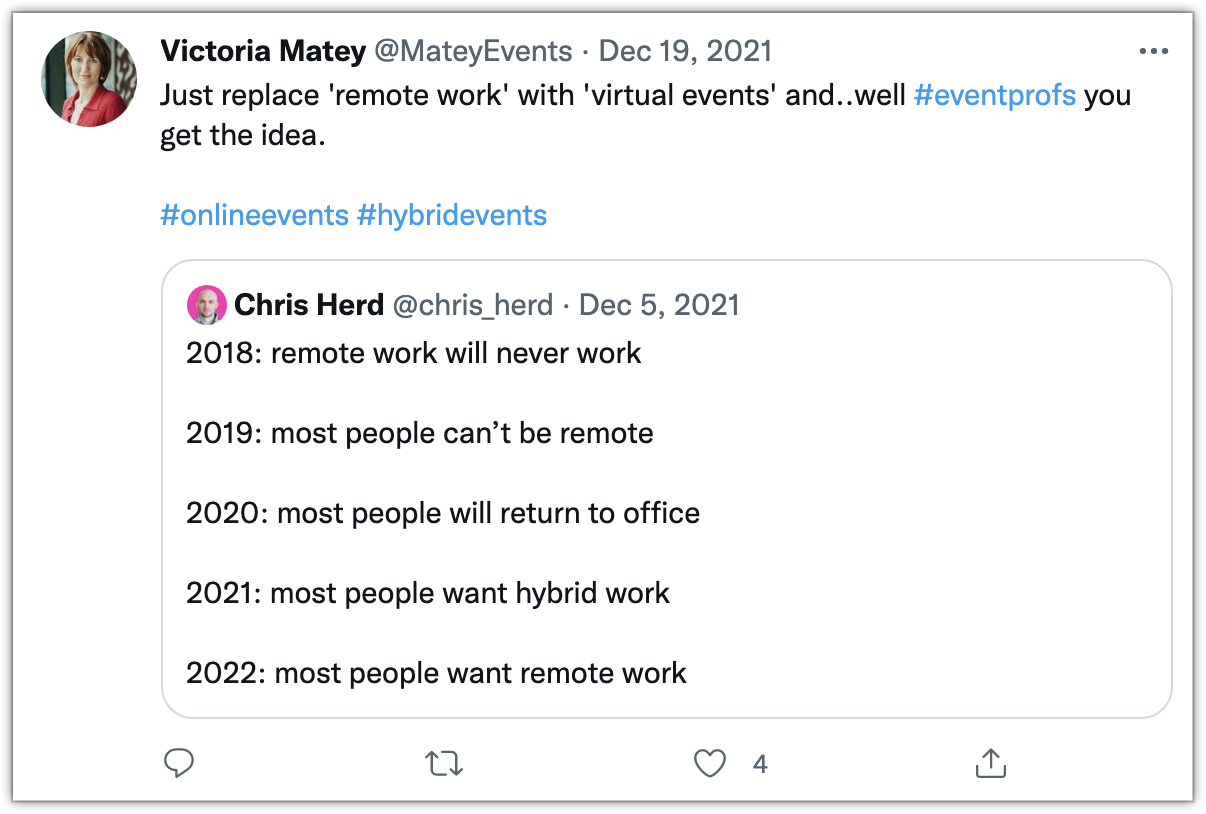
Today, let's take a look at the COVID-19 pandemic’s lingering influence on events in 2021 and other trends that have shaped our perspective of the MICE industry.
Virtual events remained a strong preference
When we entered 2021, most everyone (including us) assumed that when in-person events returned, virtual events would be sidelined. We also said people would gravitate towards hybrid events rather than just in-person or virtual ones. We were pretty wrong. According to the State of the Events Industry 2021 report by EventMB, in 2021, virtual events saw a 14% increase as the preferred event format while preference for hybrid events, on the other hand, dropped by 4%.
Another case in point would be what happened here at Zoho Backstage. Virtual events pretty much ruled the year. While in the first two quarters (owing to COVID-19 lockdowns), virtual events beat in-person ones by a large margin, many of our customers continued to carry their fondness for virtual events to the last two quarters of the year as well. This meant we saw an almost equal number of in-person and virtual events happening after June 2021.

When we analyzed why people favored virtual events, we found three main reasons: cost, reach, and sustainability. While online communities, associations, and marketers at SMBs found virtual events cheaper and more convenient to host when compared to in-person events (virtual event software has come a long, long way since the early COVID-19 times), larger companies loved virtual events for the extra reach they gave them.
Another reason many event organizers spoke up in favor of virtual events was the “sustainability” factor. When you go virtual, you cut down on both your event’s carbon footprint and waste, (not to mention the stress on the host destination) two huge issues in current times.
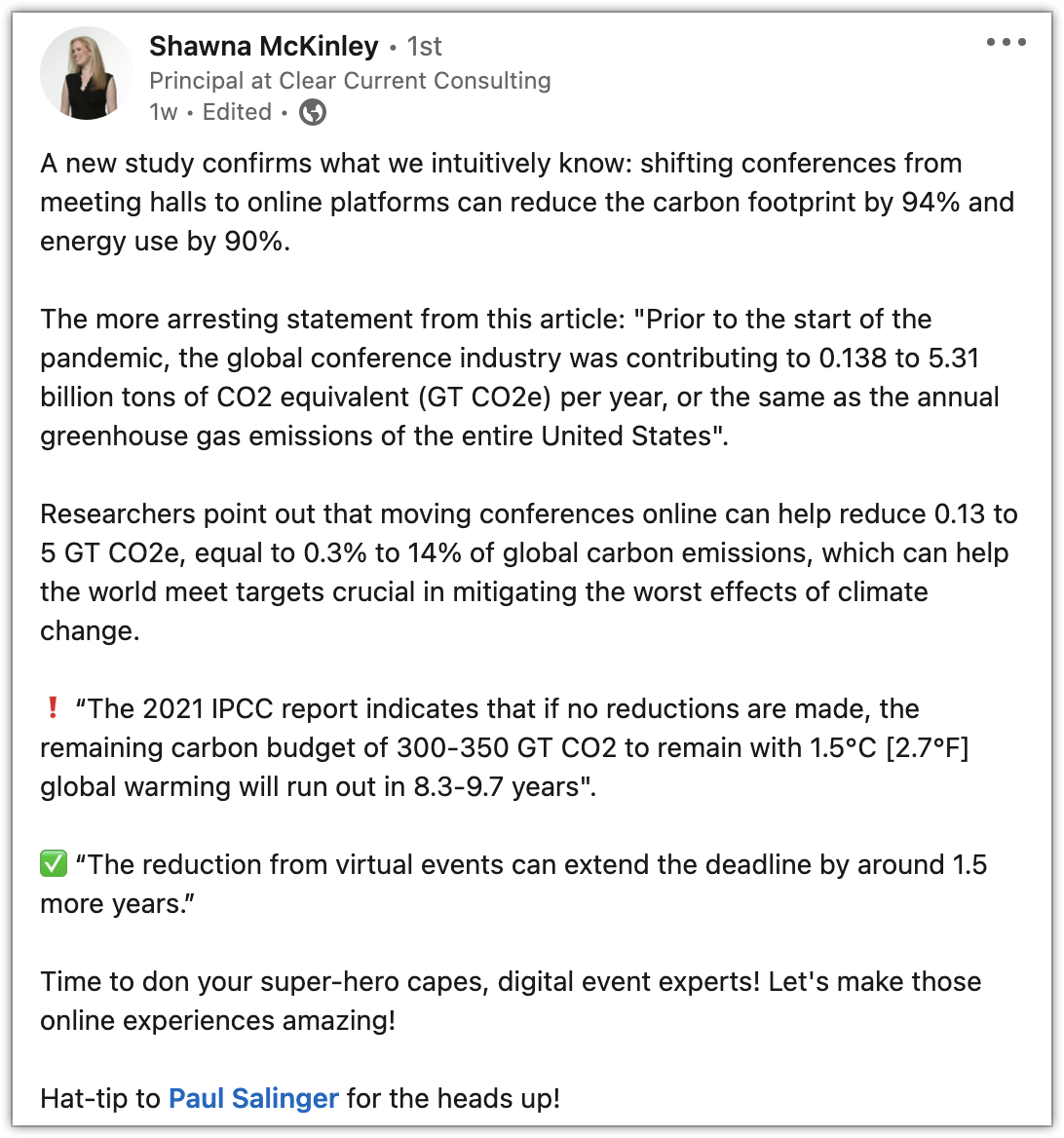
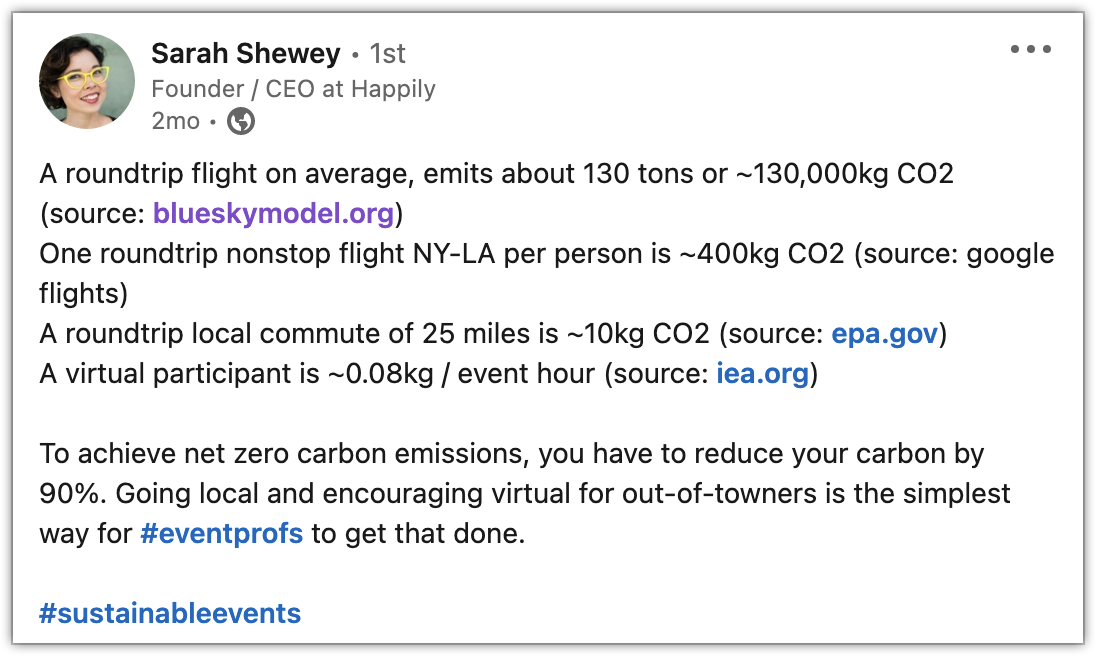
Hybrid happened, just not the way we thought it would
In 2020, we spent a lot of time talking about how hybrid events would rule the future. For the most part, we were right. In the last five months since Zoho Backstage released hybrid events, 396 hybrid events have been conducted, and many more are already in the planning stages.
In 2021, people loved the idea of going hybrid, and we saw some pretty amazing hybrid events happen globally—SecTor (Canada’s popular IT security education conference), Raisina Dialogue (India’s premier conference on geopolitics and geoeconomics), the Glasgow Climate Change Conference (COP26), and even Salesforce’s iconic Dreamforce 2021 all happened in hybrid formats. More organizations, including The Sundance Film Festival (Los Angeles, USA) and the 2022 London Wine Fair are going hybrid in the coming months.
But the peculiar thing is that most of these events aren’t hybrid in the typical way—the type where one session is presented to an onsite and virtual audience at the same time. This was the hybrid format we spoke about all through 2020. But what happened was different.
Take the London Wine Fair for example. While the in-person event will be happening on May 16 and 18, the online part of the event will happen much earlier on May 9 and 10. Even Tech Live 2021, on the other hand, happened over a period of five days with two of them being in-person and the others virtual.
Another example is Junction 2020, a hackathon that had multiple spoke venues all virtually connected for networking. (We suggest this blog by Endless Events if you’d like to know more about the various hybrid event models people have been experimenting with in the last year.)
The main reason the typical hybrid event didn’t remain a hit amongst the events community is that it was complicated. Separating the in-person and virtual elements, on the other hand, came with all the benefits of going hybrid without the extra work of coordinating simultaneous virtual and in-person experiences. In this way, the term asynchronous also made its way to the events industry: cueasynchronous hybrid events.
So, yes, hybrid is here to stay, and at The Green Room, we’re super excited to see how it’ll evolve in 2022.
Subscribe to The Green Room
Sign up here and get all the most relevant MICE industry content delivered right to your inbox once a month.
By submitting this form, you agree to the processing of personal data according to our Privacy Policy.
In-person events saw a rough comeback
Everyone knew onsite events would return. After all, despite how far virtual events have come in the last couple of years, they do have a way to go before creating emotional and sensory impact. For this, nothing beats human, face-to-face interaction. But it was easier said than done.
Event professionals had to overcome a lot of challenges, some already expected like updating their event strategy to address COVID-19 restrictions and risk mitigation. But there were also others like revenge pricing and sensory overload—the former from a combination of inflation and global supply and demand issues, while the latter from too much stimulation after more than a year of isolation. Overall, it’s been a learning experience.
[Related reading: 5 reflections on returning to in-person events beyond COVID-19 ]
Love for audio-only features peaked, then flattened
For a lot of us, especially in the event and tech industries, early 2021 will be remembered best for only one thing: Clubhouse. For almost five months (January to May 2021), we at Backstage spent around an hour (sometimes more) on this invite-only, social audio app. A lot of people did. It was, after all, the most happening place on the virtual sphere.
Netizens loved it so much that other social platforms jumped on the bandwagon and released (or announced) audio-only features on their platforms—Twitter’s Spaces, Discord’s Stage Channels, and Facebook’s Hotline. Many event tech vendors also started building audio-only networking features. All of us thought it was the next big thing.
One month later, we couldn’t have been more wrong. On June 4, Forbes published the article The Drop-In Audio App Clubhouse Is Dying. It Was Fun While It Lasted by John Brandon. More people also started acknowledging the elephant in the room—Clubhouse (and many other audio-only options on the market) weren’t accessible for deaf and hard-of-hearing people. The lack of accessibility combined with the return of in-person events and interest around the “metaverse” meant a slow disappearance of drop-in audio from conversations in the events industry.
So yes, it looks like we finally got our answer to the question we ended our Clubhouse article with on May 28, 2021: “Is Clubhouse and drop-in here to stay for the long haul?” Nope, not really.
Eventprofs advocated for positive growth in the industry
For any industry to thrive, you need people who don’t just question the status quo but who are willing to work towards being the change and creating the change. In 2021, the MICE industry came together to raise awareness in the industry about important causes like mental wellbeing, accessibility, diversity and inclusion, and sustainability.
The Events Industry Council released their Resources for Workforce and Wellness Guide to support event professionals. EventWell, the UK-based organization created in 2017 “to make tangible change to the Event Industry’s relationship with wellbeing” also ran various campaigns like Step300k and PositiviTEA to support mental wellness in the industry.
Another organization that raised awareness, but in the sphere of diversity and inclusion, was DiversityAlly. From creating a diversity committee comprising senior leaders in the events industry to champion inclusion and launching their campaign Diversity Trail at International Confex and now organizing the Diversity in Events Awards, they’ve been done a lot to create change in the industry.
The popularity of sustainable event practices also rose, and event planners started being more intentional about creating net-zero event experiences and offsetting the carbon footprint at their events. Iconic events like IMEX America and COP26 led this change by keeping sustainable event practices front and center all through the event. PCMA’s Convene magazine also dedicated their November/December 2021 issue to this cause.
Finally, coalitions like #WeMakeEvents and #SaveOurStages continued to advocate for the live events industry, raising public awareness and requesting the government’s help to protect live event workers and SMBs overcome the impact of the COVID-19 pandemic.
Wrapping up
All things considered, 2021 has been an incredibly interesting year. In a way, it’s satisfying to see how far we’ve come—we’ve raised important questions, adapted to impossible circumstances, appreciated innovation in event tech, advocated for important causes like accessibility, diversity, inclusion, mental wellbeing, and sustainable event practices.
The wheel is still turning, and we believe all these important milestones will play a huge role in defining the MICE industry’s direction in the upcoming years. We couldn’t be more excited to be a part of this progress in our own little ways—whether it’s documenting this progress at The Green Room or designing holistic event technology solutions at Zoho Backstage.
Over to you now—what did you love best about 2021 and what are you most excited about in 2022? Let us know by commenting below or tweeting us @ZohoBackstage. :)
If you’d like to stay up-to-date with all that’s happening in the event world, we recommend subscribing to our monthly newsletter. We’ll be discussing the trends shaping the events industry in 2022, plus giving you a roundup of the articles we’re publishing on The Green Room.
 Nisha
NishaMarketing and content at Zoho Backstage. Cultural misfit. Armchair traveler. Productivity geek. Sometimes, I write poetry. Sometimes, it rhymes.


